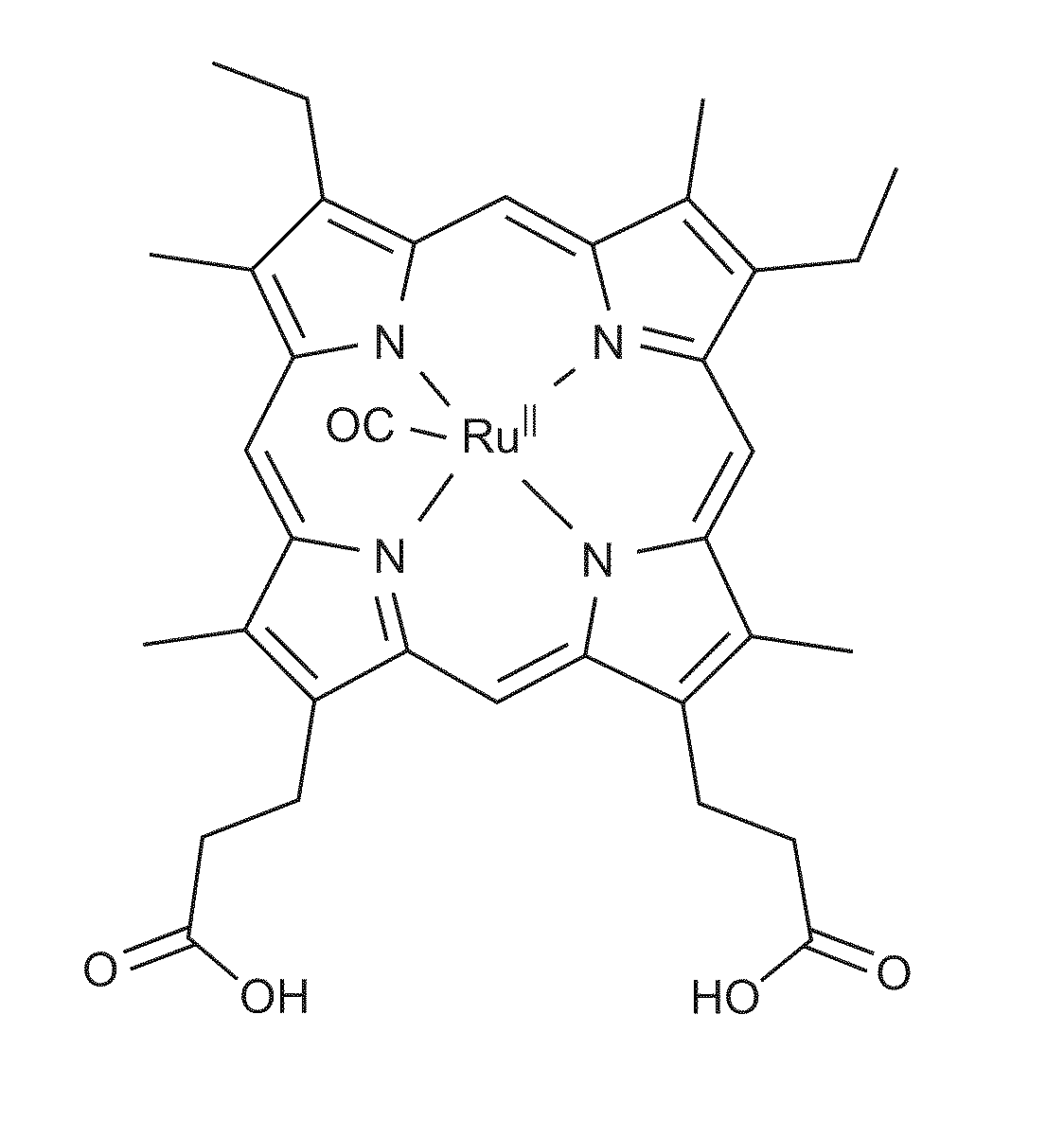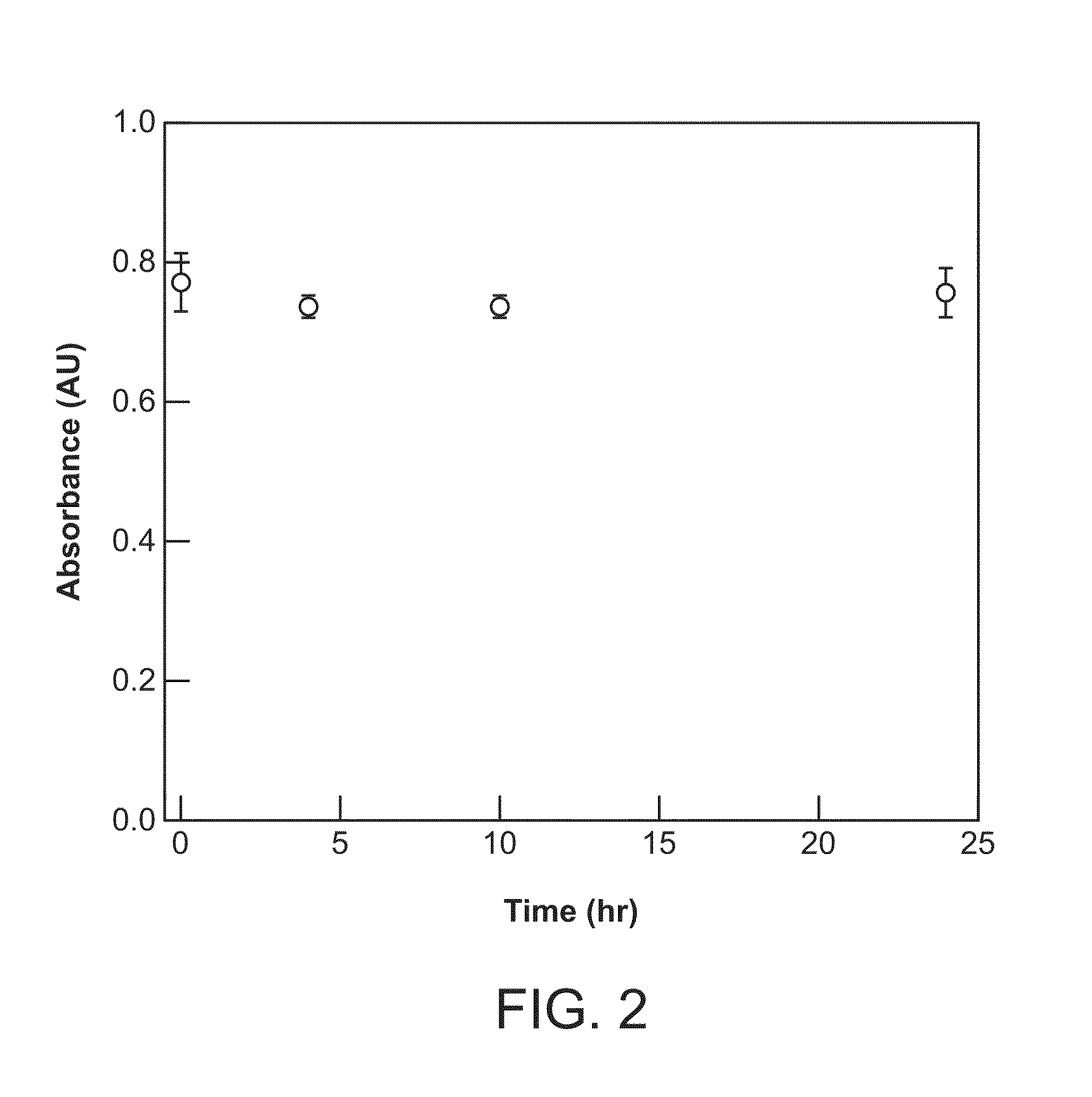Heme-binding photoactive polypeptides and methods of use thereof
a technology of photoactive polypeptides and polypeptides, which is applied in the field of heme-binding photoactive polypeptides and methods of use thereof, can solve the problems of reducing the number of viable polypeptide constructs, limiting the utility of traditional methods of photoactive porphyrin incorporation into heme-binding polypeptides,
- Summary
- Abstract
- Description
- Claims
- Application Information
AI Technical Summary
Benefits of technology
Problems solved by technology
Method used
Image
Examples
example 1
Ru-Porphyrin Protein Scaffolds for Sensing Oxygen
Materials
[0095]The following chemicals were used as received: triruthenium dodecacarbonyl (Ru3(CO)12), D-(+)-glucose, triethanolamine hydrochloride (TEA), deoxyribonuclease I (DNase I), dibasic sodium phosphate (Na2HPO4), benzamidine hydrochloride, imidazole, Tris base, trifluoroacetic acid (TFA) from Sigma-Aldrich; mesoporphyrin IX dihydrochloride from Frontier Scientific; ampicillin, terrific broth (TB), isopropyl-β-D-thiogalactopyranoside (IPTG), and N-2-hydroxyethyl piperazine-N′-ethanesulfonic acid (HEPES) from Research Products International Corp.; glacial acetic acid and dimethylsulfoxide (DMSO) from EMD Chemicals, Inc.; sodium chloride (NaCl) and glycerol from Fisher Scientific; 4-(2-aminoethyl)-benzenesulfonylfluoride hydrochloride (“Pefabloc”) from Biosynth International, Inc.; Bio-Rad Protein Assay from Bio-Rad Laboratories, Inc.; mouse plasma (with sodium citrate as an anticoagulant) from Innovative Research, Inc.; and Dul...
example 2
Pd-porphyrin Protein Scaffolds for O2 Sensing
[0130]In order to generate protein scaffolds with enhanced emission properties, phosphorescent palladium(II) mesoporphyrin IX (Cowan, J. A.; Gray, H. B. Inorg. Chem. 1989, 28, 2074-8) was incorporated into the H-NOX domain from Thermoanaerobacter tengcongensis (Pd Tt H-NOX) during protein expression using the methodology described in Example 1. Purification of Pd Tt H-NOX was carried out with established protocols (Weinert, E. E.; Plate, L.; Whited, C. A.; Olea, C., Jr.; Marletta, M. A. Angew. Chem. Int. Ed. Engl. 2010, 49, 720-3) utilizing its C-terminal His6 tag.
[0131]Purified Pd Tt H-NOX was characterized with steady-state absorption and emission spectroscopies. The Pd-containing protein displays a Soret band feature at 395 nm and bright emission at 672 nm in the absence of O2 (FIG. 8 and Table 5). Comparison to Ru Tt H-NOX reveals an increased emission quantum yield (2.5×10−2 vs. 1.7×10−4) and improved steady-state emission quenching ...
example 3
Coordination of a Pd-Porphyrin Protein Scaffold to a Quantum Dot
[0135]Pd Tt H-NOX was coordinated to a quantum dot (QD) to improve the photophysical properties of the Pd-containing protein for biological applications. QDs have numerous advantages for biological use, including high quantum yields, narrow emission line-widths, broad excitation profiles, and large two-photon absorption cross-sections. McLaurin, E. J.; Greytak, A. B.; Bawendi, M. G.; Nocera, D. G. J. Am. Chem. Soc. 2009, 131, 12994-13001.
[0136]Pd Tt H-NOX was coordinated via its C-terminal His6 tag to dihydrolipoic acid (DHLA) QDs. Delehanty, J. B.; Medintz, I. L.; Pons, T.; Brunel, F. M.; Dawson, P. E.; Mattoussi, H. Bioconjug. Chem. 2006, 17, 920-7; Dif, A.; Boulmedais, F.; Pinot, M.; Roullier, V.; Baudy-Floc'h, M.; Coquelle, F. M.; Clarke, S.; Neveu, P.; Vignaux, F.; Le Borgne, R.; Dahan, M.; Gueroui, Z.; Marchi-Artzner, V. J. Am. Chem. Soc. 2009, 131, 14738-46. Excitation of the protein / QD conjugate at 350 nm result...
PUM
| Property | Measurement | Unit |
|---|---|---|
| concentrations | aaaaa | aaaaa |
| concentrations | aaaaa | aaaaa |
| concentrations | aaaaa | aaaaa |
Abstract
Description
Claims
Application Information
 Login to View More
Login to View More - R&D
- Intellectual Property
- Life Sciences
- Materials
- Tech Scout
- Unparalleled Data Quality
- Higher Quality Content
- 60% Fewer Hallucinations
Browse by: Latest US Patents, China's latest patents, Technical Efficacy Thesaurus, Application Domain, Technology Topic, Popular Technical Reports.
© 2025 PatSnap. All rights reserved.Legal|Privacy policy|Modern Slavery Act Transparency Statement|Sitemap|About US| Contact US: help@patsnap.com



